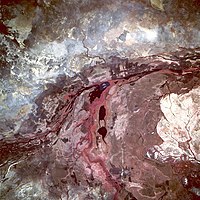
Photo from wikipedia
Introduction: The purpose of this study was to evaluate the number of roots and canal morphology of maxillary permanent molars in an Egyptian population. Methods: Six hundred fifty‐seven cases were… Click to show full abstract
Introduction: The purpose of this study was to evaluate the number of roots and canal morphology of maxillary permanent molars in an Egyptian population. Methods: Six hundred fifty‐seven cases were included in this study. Digitized images from cone‐beam computed tomographic scanning were assessed by 2 endodontists. The number of roots and canal configuration according to Vertucci were tabulated. Age, sex, and bilateral distribution differences were calculated. Results: All maxillary first molars showed 3‐root configuration, whereas maxillary second molars showed 3‐, 2‐, and single‐root configurations. For maxillary first molars, the most common Vertucci classifications for the mesiobuccal root were type II (2–1, 45.6%), type IV (2–2, 27.27%), and type I (1, 25.45%). For maxillary second molars, the most common Vertucci classifications for the mesiobuccal root were type II (2–1, 47.1%), type I (1, 42.06%), and type IV (2–2, 8.03%). The prevalence of a second mesiobuccal canal is statistically not affected by either sex, tooth position (right or left side), or age. Conclusions: Under the conditions of this study, the root canal configurations of an Egyptian population showed that the most common Vertucci classifications for the mesiobuccal root for maxillary first molars were type II (2–1), type IV (2–2), and type I (1). For maxillary second molars, the most common types were type II (2–1), type I (1), and type IV (2–2). Pre‐evaluation of the endodontic case using cone‐beam computed tomographic digital imaging provides better information of root canal morphology, which might improve the management and prognosis of the case.
Journal Title: Journal of Endodontics
Year Published: 2017
Link to full text (if available)
Share on Social Media: Sign Up to like & get
recommendations!